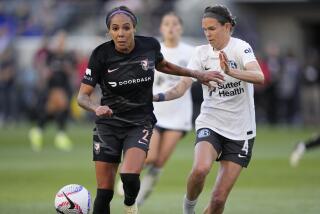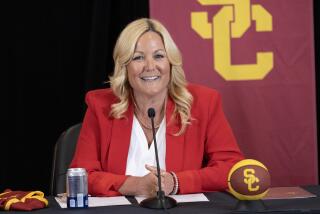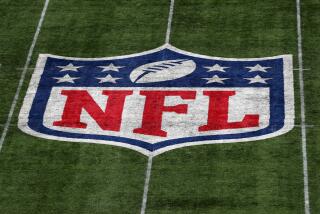NFL and USFL Talking Tough . . . but Talking : A Pretrial Settlement Plan on Expansion Is Broached
The United States Football Leagueâs $1.3-billion antitrust suit against the National Football League is scheduled to go to trial in three months.
Are the litigants looking forward to this costly fight?
Both sides say they are.
Do they mean it?
That doesnât seem likely. Nobody ever knows what any court will decide. Nobody needs a fight in which the only sure winners are the lawyers.
Is there a way out of this?
Yes, there is. The leagues could reach a pretrial settlement. In fact, that was the subject of conversation Dec. 4 when a USFL lawyer, Harvey Myerson, sat down with an NFL lawyer, Paul Tagliabue, in Tagliabueâs office in Washington.
Details of their discussion werenât reported at the time. But The Times learned this week that the attorneys considered a three-step compromise:
--Two USFL teams would be authorized to buy into the NFL before the 1986 season.
--Starting also in 1986, if practicable, a 10- or 12-team spring football league would be financed by both USFL and NFL teams.
--Periodically thereafter, the most successful of the spring franchises would advance--two at a time--to membership in the NFL.
The issues are judged to be so delicate that none of the principals would talk for publication. But sources in both camps said that the meeting was the only one so far between representatives of the two leagues.
Contrary to rumors and other speculation, the NFLâs leaders havenât been talking merger with USFL people, the sources said.
Nor would the contemplated action be a merger in the normally accepted meaning of the term.
It would be more like the great compromise of 1950 when the NFL expanded to include three teams from the old All-America Conference--the Cleveland Browns, San Francisco 49ers and Baltimore Colts.
A football merger, by contrast, is the kind of thing that happened when the NFL had finally completed its absorption of the American Football League in 1970, an operation that was three years in the making.
In the 1985 compromise discussions, neither the NFL nor the USFL is content at the moment with the otherâs proposals.
The USFL, for instance, wants the NFL to accept three of its franchises immediately, not two.
On the other hand, the NFL, when it expands, wants to bypass the USFL entirely and approve new franchises in its usual way, by choosing from applicants in many cities.
But the NFL has been planning to expand. It could expand with USFL teams. And there lies the NFLâs interest in a settlement, all sources said.
Although the NFL is confident that it can beat the USFL on antitrust, it has felt this way about other court cases, too, only to find that its confidence was misplaced.
If the NFL could get a settlement with the USFL on its terms, it would settle, most sources believe. But NFL owners canât afford to say so publicly at this time.
The USFL, meanwhile, is still balking. âSimply to get a better deal than weâll ever agree to,â one NFL source said.
The USFLâs problem is that its wealthiest owners are wealthier than many NFL owners, and all want in the NFL now, instantly, today, if not yesterday.
The USFL refuses to send just two of its top three owners to the NFL. The three are New Jersey General owner Donald Trump, Baltimore Star owner Myles Tanenbaum and Memphis Showboat owner Billy Dunavant.
The USFL wants to send Tanenbaum and Dunavant, and wants the NFL to allow Trump to stay in business in his proposed $300-million domed stadium as the NFLâs third club owner in the New York area.
But the NFL canât see that. And so it has voted unanimously and enthusiastically to go to trial in March.
âThatâs what we want to do also,â USFL Commissioner Harry Usher said. âOur goal is a separate league.â
Said USFL attorney Myerson: âWe have an overwhelmingly meritorious case.â
Many neutral observers doubt that, and the NFL scoffs at the idea. But who knows for sure? Antitrust court cases are famously unpredictable.
If, instead of fighting in court, the two leagues could agree on two new NFL teams, the second and third points in the attorneysâ three-step compromise plan could be rapidly implemented, various sources believe.
The essentials of the second point, a spring pro football league partly subsidized by the NFL, have been advocated for many years by the Raidersâ Al Davis and other owners.
âThereâs a tremendous need for a spring league where we could develop players, coaches and officials,â Davis said, noting that the USFL began with a similar small-league concept. âIt ran into trouble when it ran away from that concept.â
The proposed new league would be like a triple-A baseball league, with several modifications.
âYou could do it in many ways,â Davis said. âOne way, youâd have 10 spring teams with 40% local ownership and the rest from the NFL. If the NFL expands from 28 to 30 teams, youâd have three NFL clubs participating in the ownership of each spring team.â
Davis used Albuquerque as an example.
âLetâs say the Raiders, Chargers and 49ers each own 20% of Albuquerque,â he said. âThe Chargers would run the program one year, the 49ers the next year and the Raiders the next.â
There are also many ways in which Albuquerqueâs players could be allocated among their three NFL sponsors.
âYou could have a three-team draft in each (spring) city each year,â one NFL source said.
Whatâs in all this for the USFL or for Albuquerque--or for Jacksonville, Phoenix, Birmingham and other possible spring-franchise cities?
According to the third point, the two spring teams could advance every four years, or six years, or whenever, to NFL status.
Those advancing would be the spring teams creating the most local interest, drawing the largest local crowds, making the most money.
Each time, two other American cities could move into the spring league.
To date, NFL and USFL owners havenât been able to agree on any of this, as beneficial as much of it would be, conceivably, to all.
Indeed, theyâre in agreement now on on just one thing: They only have until March to settle or fight.
More to Read
Go beyond the scoreboard
Get the latest on L.A.'s teams in the daily Sports Report newsletter.
You may occasionally receive promotional content from the Los Angeles Times.










